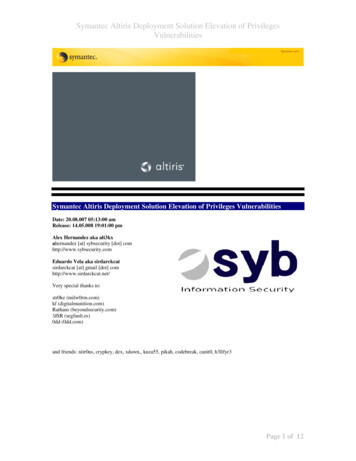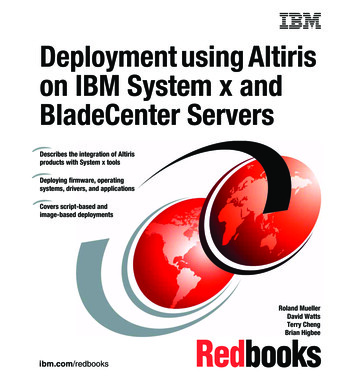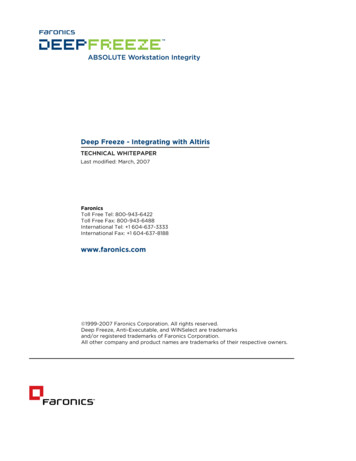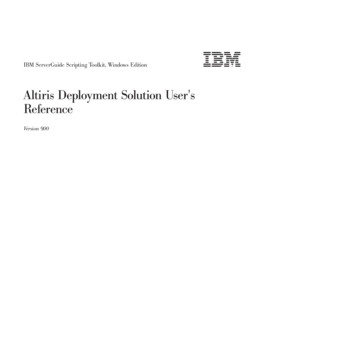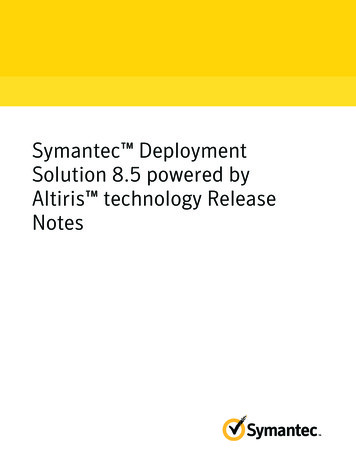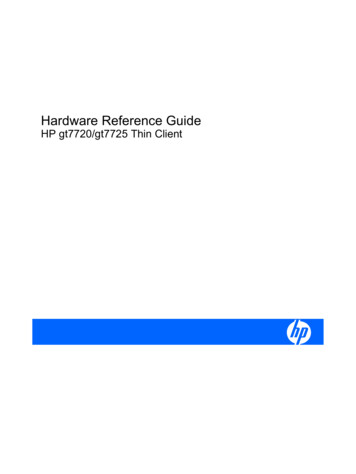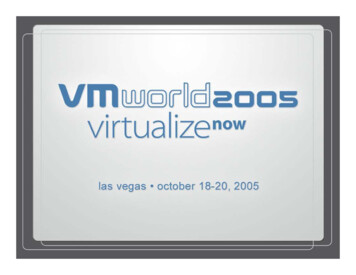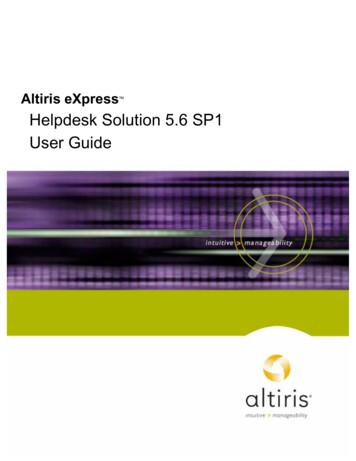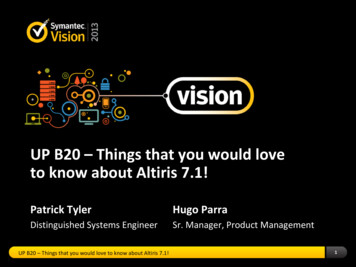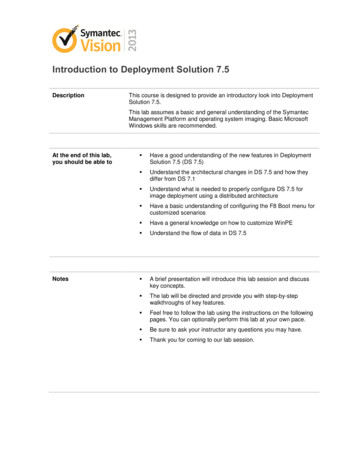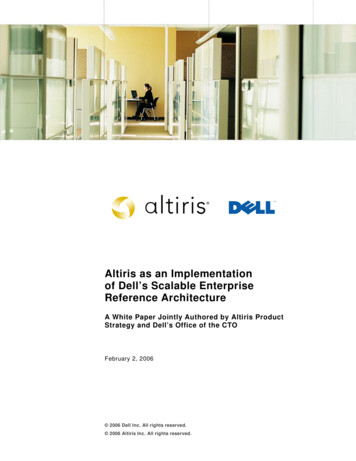
Transcription
Altiris as an Implementationof Dell’s Scalable EnterpriseReference ArchitectureA White Paper Jointly Authored by Altiris ProductStrategy and Dell’s Office of the CTOFebruary 2, 2006 2006 Dell Inc. All rights reserved. 2006 Altiris Inc. All rights reserved.
ABOUT DELL AND ALTIRISAltiris Inc. is a pioneer of IT lifecycle management software that allowsIT organizations to easily manage desktops, notebooks, thin clients,handhelds, industry-standard servers, and heterogeneous softwareincluding Windows, Linux, and UNIX. Altiris automates and simplifies ITprojects throughout the life of an asset to reduce the cost and complexityof management. Altiris client and mobile, server, and asset, network, andsecurity management solutions natively integrate via a common Webbased console and repository. For more information, visitwww.altiris.com.Dell Inc. is a trusted and diversified information-technology supplier andpartner, and sells a comprehensive portfolio of products and servicesdirectly to customers worldwide. Dell's climb to market leadership is theresult of a persistent focus on delivering the best possible customerexperience by directly selling standards-based computing products andservices. Revenue for the last four quarters totaled 54.2 billion and thecompany employs approximately 63,700 team members around theglobe. For more information, visit www.dell.com.NOTICEThe content in this document represents the current view of Altiris or Dell as of the date of publication. BecauseAltiris and Dell respond continually to changing market conditions, this document should not be interpreted as acommitment on the part of Altiris or Dell. Altiris and Dell cannot guarantee the accuracy of any informationpresented after the date of publication.Copyright 2006, Altiris Inc. All rights reserved.Copyright 2006, Dell Inc. All rights reserved.Altiris, Inc.588 W est 400 SouthLindon, UT 84042Phone: (801) 226-8500Fax: (801) 226-8506BootW orks U.S. Patent No. 5,764,593.RapiDeploy U.S. Patent No. 6,144,992.Altiris, BootW orks, Inventory Solution, PC Transplant, RapiDeploy, and RapidInstall are registered trademarks ofAltiris, Inc. in the United States.Carbon Copy is a registered trademark licensed to Altiris, Inc. in the United States and a registered trademark ofAltiris, Inc. in other countries.Dell, the Dell logo, and Dell OpenManage are trademarks of Dell Computer Corporation, which disclaims anyproprietary interest in trademarks and trade names other than its own.Microsoft, W indows, and the W indows logo are trademarks, or registered trademarks of Microsoft Corporation inthe United States and/or other countries.Other company names or products mentioned are or may be trademarks of their respective owners.Information in this document is subject to change without notice. For the latest documentation, visitwww.altiris.com.www.altiris.com
CONTENTSIntroduction. 1Architecture Overview: Dell . 2Architecture ty4Scalability4Dell’s Five Degrees of Automation5Degree 1: Solution-based Automation6Degree 2: Resource Cooperation6Degree 3: Dynamic Automation6Degree 4: Business Policy Computing7Degree 5: Virtual Data Center7Scalable Enterprise Resource Directory (SERD)7Summarizing Dell’s Components8Orchestration Components8Monitoring Components9Element Management Components9Mapping and Control (MAP) Components9Resource Manager Components10Support System Components10Application and OS Components10Architecture Overview: Altiris . 11Industry Standards11Plug-and-play Design12Cross-platform Support13Customization14How Altiris Implements Dell’s Architecture . 17Element Management Components18Mapping and Control (MAP) Components18Monitoring Components19Orchestration Components19Resource Manager Components19Support System Components20Application and OS Components20Standardizing: The Goal of Working Together20Altiris and IT Infrastructure Library (ITIL)23www.altiris.com
Conclusion . 25References . 26www.altiris.com
INTRODUCTIONThe common goal ofAltiris and Dell is to helpsimplify IT management.This white paper is jointly authored by Altiris Product Strategy and Dell’sOffice of the CTO in an effort to demonstrate alignment between Dell’sScaleable Enterprise vision and Altiris architecture. Dell’s position as amajor hardware vendor dramatically influences manageability standardsand hardware design while Altiris’ position as a leading ISV directlyaddresses lowering overall Dell hardware total cost of ownership (TCO)as part of a larger automated, remote management framework.Dell and Altiris first formed a strategic relationship in 2002 to provideoptimized client system lifecycle management for Dell customers with thelaunch of OpenManage Client Administrator (OMCA). OMCA is built onthe Altiris Infrastructure and has an expanded set of hardwarecapabilities designed to help our customers reduce the cost of owningand managing Dell client systems. We extended our collaboration toserver management in 2004 through 2005 with the introduction of Altiris Server Management Suite for Dell Servers and its associated Dellspecific components. We continue to collaborate closely, as partners andmutual customers, on products that deliver value today and standardsthat preserve alignment with long-term considerations. Our common goalis to help simplify IT management.As the market moves toward ever-increasing levels of data centerautomation, customers are faced with the challenge of evaluating thematurity and “fit” of evolving management solutions. In an effort toprovide some guidance for these customers, Dell has developed itsScalable Enterprise Reference Architecture (hereafter referred to as theDell architecture). This model describes the components, workflow, andcapabilities that Dell recommends as key considerations for thosecustomers striving to balance short-term management needs with longterm business goals.This white paper validates the Altiris solution as an implementation ofDell’s reference architecture and explains how Altiris is aligned with whatDell foresees.www.altiris.comAltiris as an Implementation of Dell’s Scalable Enterprise Reference Architecture 1
ARCHITECTUREOVERVIEW: DELLThis section briefly reviews the key components and concepts of Dell’sreference architecture so that later comparisons to the Altiris solution setare more readily understood.Architecture DriversThe four key drivers of the Dell architecture align closely with the Altirismodel. These are: Standardization Flexibility Interoperability ScalabilityStandardizationThis is the primary driver in Dell’s vision of data center evolution. Delldefines standardization to include both de facto and engineeringstandards, but tends to place greater emphasis on de facto standards;that is, those technologies proven effective by market adoption.In addition, Dell defines “standardized” servers to be ia-32/x-86instruction set machines with one to four CPU sockets.The Altiris service-oriented architecture (SOA) is similarly rooted instandards, both engineering and de facto. Altiris incorporates HTTP/Sand XML as the primary transport mechanism for client/server and interserver communication. Altiris also offers Altiris Connector Solution ,which provides a two-way data exchange with the Altiris Database andthird-party systems via common data formats.Altiris also recognizes the usability gains and lower TCO benefits of defacto standards such as Microsoft’s .NET Framework technologies asimplemented by backend server components and the Altiris Web-baseduser interface. Additionally, Altiris utilizes Microsoft SQL 2000 as itsdatabase format and leverages Windows-based authentication along withan NTFS-like permissions hierarchy in its role-and-scope-based securitymodel.Altiris uses other standards, including DCOM and SOAP, and is amember of the Distributed Management Task Force (DMTF). DMTFstandards provide common management infrastructure components forinstrumentation, control, and communication in a platform-independentand technology neutral way.Altiris provides a leading heterogeneous management platform, which itscustomers value because it allows them to centrally manageenvironments of mixed hardware, operating systems, and devices fromthe consolidated Altiris Console. And while Altiris offers support for2 Altiris as an Implementation of Dell’s Scalable Enterprise Reference Architecturewww.altiris.com
Windows, Linux and UNIX data center environments, Altiris recognizesthe dominance of the x86 servers and therefore dedicates a majority ofdevelopment resources and roadmap focus to this market segment.The Dell architecture proposes that standards-based solutions arelargely “future proofed” because they offer the highest and mostenduring degree of flexibility, interoperability, and scalability—the otherkey drivers in Dell’s model.FlexibilityThe Altiris SOA allows allAltiris solutions to utilizea common backend thatmanages and optimizesclient/servercommunication, agentmanagement, dataprocessing, policyexecution, role-andscope-based security,Dell suggests a management model comprised of basic building blocksthat can work autonomously or snap together for an integrated end-toend configuration. Flexibility also requires adaptability to new standardsand technologies as they emerge over time. Dell’s model is extremelypragmatic in that it readily identifies data center management as arapidly maturing market. While significant automation opportunities existtoday, Dell recognizes that the market is rapidly evolving to addressexisting gaps.Similarly, Altiris solutions are delivered as individual building blocks thatcan function independently or as a part of a larger Altiris frameworkwhere data and functions are leveraged across solution modules. Altirissolutions can be purchased as standalone tools or deployed asintegrated suites to address comprehensive IT processes and workflows.database connectivity,and third-partyintegration.The Altiris SOA allows all Altiris solutions to utilize a common backendthat manages and optimizes client/server communication, agentmanagement, data processing, policy execution, role-and-scope-basedsecurity, database connectivity, and third-party integration. The flexibilityof starting with a single solution with the option to move to a seamless,integrated platform in the future is a compelling Altiris value proposition.Because individual solutions map to the larger Altiris framework,customers who purchase an individual Altiris solution targeted at solvingimmediate problems are also building a foundation for the future. Thecustomer has the option of adopting the larger solution set as needs,infrastructure, and budgets evolve.Altiris’ flexibility as a solution is further realized in the Altiris Consoledesign philosophy. For example, every page (report, policy, and view) inthe Web-based Altiris Console is directly URL-addressable. Customerscan easily build custom Web-based views that include just those tasks orreports that are meaningful to them for quick access from a customerintranet set or a list of browser favorites. Altiris’ role-and-scope-basedsecurity continues to govern access to each page, even if it is accesseddirectly by a URL. This design feature provides the ability to mix andmatch presentation layer access with far great flexibility than competingtechnologies such as a MMC or standalone Win32 console.www.altiris.comAltiris as an Implementation of Dell’s Scalable Enterprise Reference Architecture 3
The use of aforementioned technologies such as XML, SQL, and SOAPincrease the flexibility of Altiris solutions.InteroperabilityDell defines any model that is standardized as “open.” This assurescustomer choice across all aspects of data center management.Similarly, Altiris realizes that customers will often need to integrate theAltiris Console and data with third-party systems. To facilitate thisintegration, Altiris offers multiple connectors that provide neededintegration out-of-the-box. For example, customers may choose tomaintain a Remedy help desk instead of using Altiris HelpdeskSolution , or they may choose to integrate with HP OpenView instead ofusing Altiris Monitor Solution . In these cases, Altiris connectors canprovide user interface and data integration across multi-vendorenvironments.For those cases where Altiris does not offer a pre-built connector, AltirisConnector Solution allows customers to build their own policies forexporting any Altiris data classes to and from the system eitherscheduled or on-demand using one of several standard formats,including XML, CSV, and ODBC.Whenever possible, Altiris avoids a proprietary and/or agent-basedimplementation. For example, Altiris personality packages that containcustom user data and settings are stored as self-extracting executableswith a rich command-line interface. These packages can be appliedentirely outside the Altiris management infrastructure if need be. Theycan be delivered and scripted by a variety of Altiris or non-Altiris tools.Furthermore, Altiris software delivery packages do not utilize any kind ofproprietary wrapper. Instead, Altiris leverages its award-winning Wisesoftware packaging technologies to create standard *.msi packages andleverage the many advanced installation and self-healing characteristicsof this package format.As another example, Altiris Deployment Solution provides extensivebare-metal server provisioning features and includes as part of itsworkflow the ability to insert any “Run Script” task as part of an Altirisjob. Customers can use these tasks to insert any DOS commandlanguage (batch file), VBscript, or Linux shell at any point in a customerdefined workflow. This capability allows users to wire together Altiris andnon-Altiris management functions into a comprehensive solutiondesigned to offer customers the ultimate in flexibility and ease-of -use.ScalabilityDell’s architecture insists that solutions not only be able to scale asinfrastructure expands, but that they deliver at the point of customerneed—without pushing beyond it or falling short. To demonstrate this4 Altiris as an Implementation of Dell’s Scalable Enterprise Reference Architecturewww.altiris.com
concept, Dell proposes “Five Degrees of Automation” and suggests thatnot every customer will benefit from the highest level of automation.Solutions must be capable of delivering subsets of automation acrosssolution sets, perhaps in combination with more manual controls, tailoredto precise customer needs. This functionality allows customers to takedelivery of needed management functions as they grow and in exactproportion to needs without enormous initial investments in managementsoftware.As previously discussed, Altiris solutions support this model. Customerscan purchase the one or two solutions they need today while maintainingthe option to add more solutions in the future. With each additional Altirissolution installed, the customer realizes new functionality as solutionsextend across each other to expose new levels of manageability. Forexample, when both Altiris Inventory Solution and Altiris ApplicationMetering Solution are installed, additional data correlations can beviewed that are not possible with either product independently. Thesereports can quickly and easily provide administrators with “installed vs.used” data. Altiris can identify what software is installed via AltirisInventory Solution and what software is actually being used via AltirisApplication Metering Solution. With both solutions installed, the AltirisConsole can correlate the data from each solution in a new series ofreports that extend the value of the system beyond that of its individualsolutions.The common Altiris data model does not limit this concept just to reportsbut supports it across collections, policies, notification alerts, etc.Customers can create their own increasingly customized and automatedscenarios by pulling from data sets that simultaneously span manydifferent Altiris modules.Dell’s Five Degrees of AutomationAs a corollary to its primary architecture drivers, Dell’s Five Degrees ofAutomation suggest a maturing evolution toward data centermanagement. In some cases, a higher order degree may be dependenton a lower order degree, but not necessarily. Barriers remain in themarket that challenge management providers in delivering on the higherautomation degrees Dell identifies. Foremost among these is the lack ofstandards and/or standards implementation. Figure 2 shows the fivelevels with a brief description of each.www.altiris.comAltiris as an Implementation of Dell’s Scalable Enterprise Reference Architecture 5
Figure 2Dell’s Five Degrees ofAutomation comprise Dell’sscalable enterprise technologyprogression.Degree 1: Solution-based AutomationExamples of solution-based automation include Oracle, SAP, andMicrosoft Exchange. At present, these applications do not adhere to acommon interface that allows external processes to manage them withsimilar calls and functions. These applications are highly unique andrequire application-specific knowledge and tools to automate theirconfiguration.Custom scripts can be created and called from external processes, butno common object model can be leveraged across all of them until newstandards are created and then implemented by the various vendors.Any prepackaged automation remains application-specific and requiresunique maintenance and configuration.Degree 2: Resource CooperationAutomated common infrastructure supports cooperation between groupsof discrete solutions. Server virtualization can help enhance equipmentutilization, and a reduction in the number of physical servers can reduceoperational costs and staffing. A common infrastructure provides themeans to automatically manage systems and operations at a commonresource level.Degree 3: Dynamic AutomationDynamic automation begins to enable end-to-end, service-orientedautomation by establishing enterprise management and orchestrationamong groups. Specifically, this degree introduces tools that allow thedata center to automatically allocate or reallocate resources based on aset of operational criteria defined by service needs.6 Altiris as an Implementation of Dell’s Scalable Enterprise Reference Architecturewww.altiris.com
Degree 4: Business Policy ComputingThe goal of the virtualdata center is toautomate every aspectBusiness-based computing represents a model in which business goalsand motivations become the key IT driver. This degree represents ahighly flexible, standardized infrastructure in which technical servicesbecome the commodity.of an organization’sbusiness operations andDegree 5: Virtual Data Centerenable such operationsThe connection between an application and the underlying physicalassets on which it is executed will have little relevance. The goal of thevirtual data center is to automate every aspect of an organization’sbusiness operations and enable such operations to be configured orreconfigured as needed to achieve maximum business effectiveness.Much of the actual construction and operation of a fifth-stage virtual datacenter remains to be determined.to be configured orreconfigured as neededto achieve maximumbusiness effectiveness.Scalable Enterprise Resource Directory (SERD)Dell anticipates growth in the formulation of its Scalable EnterpriseResource Directory or SERD, which Dell sees as the natural evolution ofthe Change Management Database (CMDB) and a precursor to datacenter automation ideals. The fundamental value of the SERD isinterface standardization.Figure 3Dell sees its Scalable EnterpriseResource Center as thebackbone of interfacestandardization.www.altiris.comAltiris as an Implementation of Dell’s Scalable Enterprise Reference Architecture 7
Today, APIs are the fundamental interface to drive system integration.APIs between vendors can implement different object models and requireextensive education and development efforts to leverage. Because eachvendor considers their offering to be the source of truth, APIs exist tobridge these sources without appealing significantly to the need for arecognized, centralized source of truth that vendors take direction from.The SERD is essentially a standardized catalog of data—a commonobject set based on XML and CIM standards. The value of the SERDdata model is that it serves as the source of truth and fundamentalinterface for integration and management tasks. As objects are createdand relationships are defined in the SERD, all downstream layers in themodel adjust to physically instantiate what exists in the directory. Allmanagement systems look to the central SERD as the source of truthand actuate what exists there (or notify administrators of existing gaps).The SMASH standard is simply an intermediate step toward the SERD.First vendors will align programmatic interfaces (SMASH) with theeventual realization that a common data model (the SERD) is the ideal,unifying approach.Summarizing Dell’s ComponentsThe next chapter discusses how the Altiris SOA maps into the Dellarchitecture. However, it is important to briefly review the keycomponents of the Dell model: Orchestration Monitoring Element management Mapping and control (MAP) Resource managers Support system Application and OSOrchestration ComponentsThis component layer understands what relationships should exist inSERD and initiates actions to instantiate those relationships.Orchestration bridges monitoring data with operational processes.Today, custom scripts serve much of this function. However, though theyaddress the problem, they are not flexible and can be difficult toprecisely define.8 Altiris as an Implementation of Dell’s Scalable Enterprise Reference Architecturewww.altiris.com
Monitoring ComponentsDell suggests monitoring components perform two primary functions: Targeting non-compliant behavior in the system; operations alignwith policies (can be agent or agentless). Exception processingbegins here and is passed to the orchestration layer and resourcemanager for resolution. Implementing relationship modifications as directed by theorchestration layer and reconciling them with SERD. Ensures thatwhat is in SERD is congruent with what orchestration requested.Any differences in comparing actual with expected notes is anexception.Element Management ComponentsDell defines element management as the layer of intelligence thatoperates specific standard platform types (server, storage and fabric).Ideally, Dell encourages standardization of configuration interfaces viasuch initiatives as SWMG’s SMASH proposal. For the time being,however, Dell recognizes that more proprietary interfaceimplementations are required. This elemental layer includes such toolsas Dell’s OpenManage Server Administrator (OMSA) for servermanagement or Dell’s OpenManage Switch Administrator for networkfabric management.Mapping and Control (MAP) ComponentsMAP components manage the current relationships of all components inthe Dell architecture; that is, the “as is” state of each relationship. Thislayer is tightly associated with physical data center operations andcontains three primary functions:Operational managementThis component directly interfaces to each element component and isresponsible for groupings, bindings, and provisioning. Operationalmanagement translates global operational directives into operationaldirectives.ProvisioningThis component allows for a flexible, efficient, and extensible servermanagement environment. For example, bare metal to OS to applicationprovisioning, be they physical or virtual machines.www.altiris.comAltiris as an Implementation of Dell’s Scalable Enterprise Reference Architecture 9
VirtualizationVLANs and SANs are popular examples in today’s data centers; all stateinformation is abstracted from the physical resource. Virtualization layer placed between hardware and OS (GSX orvirtual server) Virtualization embedded into the host OS (ESX)Resource Manager ComponentsResource manager components interpret how to operate and utilize aspecific type of managed resource (server, storage, and fabric).Support System ComponentsSupport system components are self-contained entities that helporchestration and resource managers control system-wide behavior. Forexample, an isolated function leveraged by a higher order component inthe model.Application and OS ComponentsDell proposes that as the data center evolves, applications and operatingsystems will become increasingly intertwined. For example, in a VMwareESX server, the host OS aligns with the hardware while the guestoperating systems are tuned more for the applications they support.10 Altiris as an Implementation of Dell’s Scalable Enterprise Reference Architecturewww.altiris.com
ARCHITECTUREOVERVIEW: ALTIRISNow that we’ve reviewed key aspects of Dell’s reference model, we canbegin to map Altiris conventions into it. This chapter provides anoverview of the Altiris SOA and begins to position it as animplementation of Dell’s vision.The Altiris SOA is fundamentally a management environment thatprovides a common set of services to all Altiris solutions, includingprocesses such as:Due to a commonarchitecture, Altiris Client/server communications Data modeling and processing Web publishing Security Repository structure and maintenanceThese shared components provide a number of advantages to both thecustomer and Altiris: Any updates to these core components benefit virtually all of theAltiris products, improving the efficiency of Altiris solutions’development teams by allowing them to focus on solvingcustomer pain points. Solutions developed on the Altiris SOA automatically integratewith other supported solutions. Customers buy only what is needed today with the confidencethat management capabilities can easily be expanded as theircompany grows and business needs change. Altiris solutions areeffectively “future-proofed” in this way. Due to a common architecture, Altiris products speed ROI andmaximize TCO reduction in many ways, including the ability totarget management functions when and how they are neededusing a single, leveraged infrastructure.products speed ROI andmaximize TCO reductionin many ways, includingthe ability to targetmanagement functionswhen and how they areneeded using a single,leveraged infrastructure.Industry StandardsThe Altiris SOA is built on the .NET Framework and uses industrystandard technologies for storing, processing, and presenting dataacross distributed networks and the Internet. For example, by leveragingthe HTTP/S protocol for client/server/console communications, Altirisensures efficient, secure transmission of data across network segmentsor through the firewall.The Altiris SOA also supports XML and SQL, which ensures that theAltiris Database is consistent and extensible, making it easy to associateand correlate data between Altiris solutions or third-party managementwww.altiris.comAltiris as an Implementation of Dell’s Scalable Enterprise Reference Architecture 11
tools. Other industry standards and initiatives leveraged in the AltirisSOA include:The Altiris SOA allows WBEM (Web-Based Enterprise Management) CIM (Common Information Model) WMI (Windows Management Instrumentation) DMI (Desktop Management Interface) SMBIOS (System Management BIOS) SNMP (Simple Network Management Protocol) WSDL (Web Services Descriptive Language) LDAP (Lightweight Directory Access Protocol)Supporting these technologies enables Altiris to speed productdevelopment lifecycles, shorten product time to market, and betterconnect with customers.additional solutions to besnapped in to extendPlug-and-play Designfunctionality,Many vendors who claim to do lifecycle management are actuallyfocused on one aspect of the IT lifecycle, such as software distribution,while providing a list of partners who offer tools for other phases of thelifecycle, leaving customers to the details, such as the implementationand integration of disparate technologies from multiple vendors.Conversely, the Altiris SOA allows additional solutions to be snapped into extend functionality, simultaneously providing native integration andminimizing implementation efforts.simultaneously providingnative integration andminimizingimplementation efforts.This plug-and-play design results in lower implementation and trainingcosts, and because the new solutions operate efficiently on a sharedplatform, there is no need to dedicate resources to an integration project.In addition, a shared platform enables Altiris to provide a commonsecurity model, data model, agent management, and console integrationthat partnerships just cannot deliver.12 Altiris as an Implementation of Dell’s Scalable Enterprise Reference Architecturewww.altiris.com
Figure 4Altiris' service-orientedarchitecture allows an Altirissolution to leverage any otherAltiris solution’s data. Thismodel allows Altiris to usepolicies to force actions.Thanks to this flexible design, the Altiris SOA allows customers to buyonly what they need today, but with the confidence that they can expandtheir management capabilities as their business grows and changes.This service-oriented architecture allows an Altiris solution to leverageany other Altiris solution’s data. This model allows Altiris to use policiesto force actions. For example, BIOS revision data for a Dell serverobtained by Altiris Patch Management Solution for Dell servers canbe used to define a collection for use by an Altiris ApplicationManagement Solution policy. As more Altiris solutions are added to theframework, bene
www.altiris.com Altiris as an Implementation of Dell's Scalable Enterprise Reference Architecture 1 This white paper is jointly authored by Altiris Product Strategy and Dell's Office of the CTO in an effort to demonstrate alignment between Dell's Scaleable Enterprise vision and Altiris architecture. Dell's position as a
